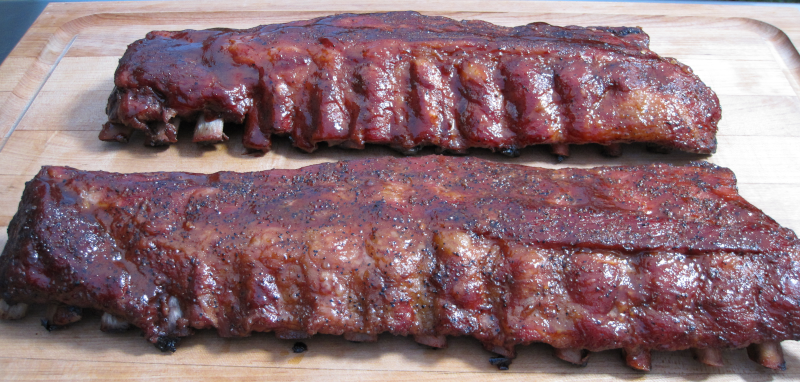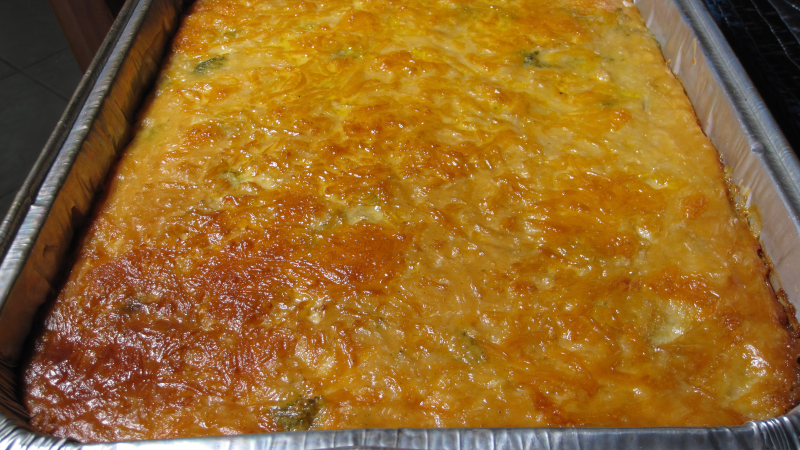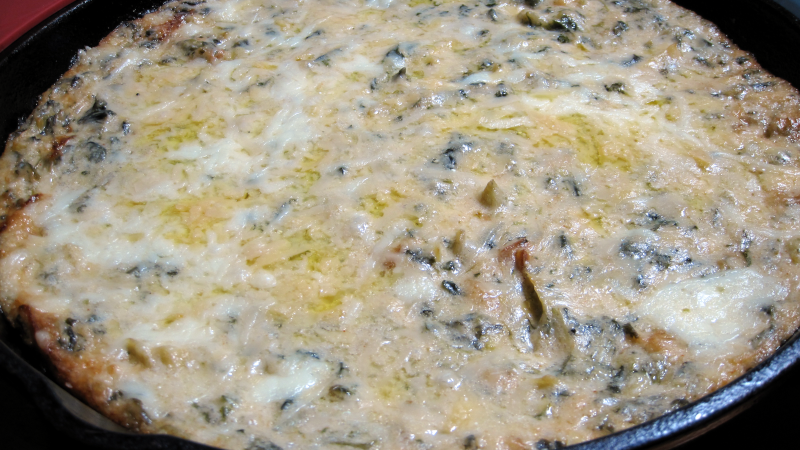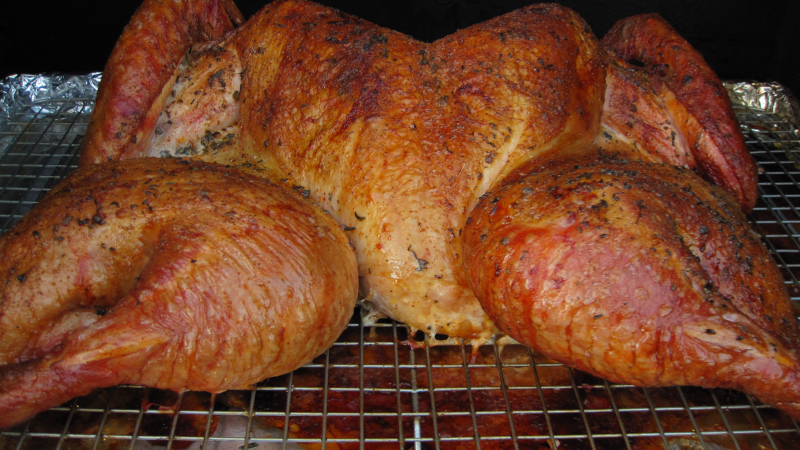Easy Pellet Smoker 221 Baby Back Ribs

Welcome to the world of smoky indulgence! Prepare to embark on a culinary journey that will delight your senses and leave you craving for more. Get ready to sink your teeth into succulent and tender smoked baby back ribs, a true barbecue masterpiece. These ribs are a testament to the art of slow cooking, infused with smoky flavors that penetrate the meat, creating a symphony of taste and texture. Whether you’re a seasoned pitmaster or a novice backyard griller, the allure of smoked baby back ribs is simply irresistible. So, let’s dive in and discover the mouthwatering magic that awaits with each bite. Get ready to savor the essence of smokiness, paired with the juiciness of perfectly cooked meat, as we unravel the secrets behind this beloved barbecue classic.
Man That’s Cooking
Ingredients
- 2 racks pork loin ribs
- 3 tbsp yellow mustard
- 4 tbsp BBQ rub
- 1/2 cup BBQ sauce
- 1/2 stick butter
- 1/4 cup brown sugar
- 1 tbsp honey
- 1 tbsp tiger sauce
Directions
First, get your smoker started at 235 F with cherry and hickory wood pellets. If you have a smoke tube, get that lighted as well with cherry and hickory pellets.
To prep the ribs, first lay them meat side down and use a boning knife to trim off any extra fat. If there are any fractional bones at the ends, trim them off as well. Next use a butter knife to work it under the membrane and then use a paper towel to grip it and pull off the membrane.
Spread some yellow mustard everywhere to act as a binder for keeping the BBQ rub on the ribs. You won’t taste the mustard so don’t worry about that. Next put down a first layer of a salt pepper garlic based rub such as Killer Hogs AP rub. Next add a rub that has paprika and brown sugar such as Meat Church Holy Voodoo.
Flip the ribs over and check the meat side for excessive fat to trim off. Next repeat the mustard and rub application steps on the meat side.
When the smoker reaches temperature place the ribs in the smoker and push the ends towards each other to compact the ribs as much as possible. Smoke the ribs for one hour, then spritz them with apple juice, cider or apple cider vinegar to keep them moist. You can add other flavors to your spritz but you probably won’t taste it. Continue to cook for one more hour and on this third hour, it’s time to wrap the ribs.
Pull 2 sheets of heavy duty aluminum foil. Place slices of butter on the center of the foil. Add some honey, brown sugar, and splash on some Tiger Sauce. Place the ribs meat side down onto this mixture. Add some butter, dry rub, and Tiger Sauce to the bone side of the ribs. Wrap them tightly in the first sheet of foil, then wrap them again in the second sheet. Place the ribs meat side down in the smoker and continue to cook them for two more hours.
After two hours, pull the ribs and unwrap them. Place them back on the smoker meat side up. Glaze them down with your favorite BBQ sauce and let them cook for 1 more hour until they reach 195 F. You may need to increase the smoker temp a little bit to 250 F to get this done within an hour. When you pull the ribs, let them rest for 5 minutes before slicing.
 Print This Recipe
Print This Recipe
Watch How To Make This Recipe
Pellet Smoked Cheesy Broccoli Rice
Pellet Smoked Cheesy Broccoli Rice

Sometimes a good meal needs a killer side dish. This is one of those crowd feeding side dishes that has your back on the holidays or for any get together cookout. Even if you have a small eating crew, the leftovers will freeze well for another day. Smoked cheesy broccoli rice pairs so well with many other foods that it might become your go to side dish. Kids love the cheese flavor, grandparents missing teeth love it, you just can’t go wrong.
Man That’s Cooking
Ingredients
- 2 heads of whole broccoli
- 1 yellow onion
- 2 cups white rice
- 32 oz chicken broth
- 16 oz cheddar cheese
- 8 oz swiss cheese
- 8 oz mozzarella
- 1 quart milk
- ½ cup all purpose flour
- 1 stick (8 tablespoons) butter
Directions
First, hand shred the cheddar, swiss, and mozzarella cheeses and set this aside in a large bowl. Keep about 1 cup (8oz) of cheddar cheese off to the side for later topping.
Next, remove the large stems from the broccoli florets. Cut the florets into small sizes. Chop parts of the stems into small bits. Par boil the broccoli for no more than 5 minutes then drain in a colander. Run cold water over the broccoli to stop the cooking process.
Finely dice the onion and fry for about 5 minutes until the onion starts to turn translucent.
Bring the 32 oz of chicken broth to a boil, then add the 2 cups of white rice. Reduce the heat to a simmer and cook for 20 – 25 minutes until rice is cooked and tender.
Next prepare the bechamel starting by melting the butter in an 8 qt pot on medium heat and stirring in the flour with a wooden spoon. Cook until it turns light brown, then slowly incorporate the room temperature milk. Next slowly incorporate the cheese and stir with a whisk when the mixture becomes thick.
Finally add the broccoli, onion and rice into the cheese sauce and mix together. Pour the final mixture into a 9×13 foil pan. Top with the shredded cheese that was set aside.
Smoke with pecan or apple pellets at 250F for 3.5 hours.
 Print This Recipe
Print This Recipe
Watch How To Make This Recipe
Pellet Smoked Spinach Artichoke Dip
Pellet Smoked Spinach Artichoke Dip

Who doesn’t love a good spinach artichoke dip when you are watching “The game that lawyers won’t let us mention”. But have you ever tried a smoked version of this dip? Sure we all know what the TGI Friday’s Chili’s Applebee’s Ruby Tuesday’s (RIP) local sports bar dip is like and heck it ain’t that bad… usually. But there is something special about a smoked version of this dip with your own hand selected cheeses. One could only guess how your favorite restaurant prepares their dip, maybe it’s all a frozen pre-mix in a plastic bag. But you have a pellet smoker and free will so you can make some fresh and delicious smoked dip! The good part about this recipe is that you can do all the prep work a day or two ahead of the cook day. When you are ready, all you need to do is put this dip on your smoker and enjoy.
Man That’s Cooking
Ingredients
- 14 oz can artichoke hearts
- 10 oz frozen spinach
- 1 cup sour cream
- 1/4 cup mayonnaise
- 8 oz cream cheese
- 8 oz gouda cheese
- 8 oz mozzarella cheese
- 8 oz parmesan cheese
- 1/2 teaspoon garlic powder
- 1/2 teaspoon smoked paprika
- 1/4 teaspoon cayenne pepper (optional)
Directions
First, thaw out the frozen spinach overnight in the refrigerator. On the next day when you are ready to start, remove the cream cheese from the refrigerator and allow it to soften on the kitchen countertop.
Next open the can of artichoke hearts and drain out the water. Using paper towels, squeeze out the excess water from the artichoke hearts. Roughly chop the artichoke hearts and place them in a large mixing bowl.
Next open the package of the thawed out spinach and drain out the water. Using paper towels, squeeze out the excess water from the spinach. The spinach should already be chopped but if not, chop it. Add the spinach to the large mixing bowl.
Next grate the gouda, mozzarella, and parmesan cheese then set aside a small amount from each (about ½ cup total) for a topping and add the rest to a large mixing bowl. Add the softened cream cheese, mayonnaise and sour cream, then mix everything together. Add the spices and mix everything once again. At this point you can cover the mixing bowl with plastic wrap and place it into the refrigerator if you plan to cook the dip the next day.
Preheat your smoker at 250F and use mild pellets such as apple or competition blend. The total smoke time should be at least one hour and 20 minutes but you can cook for longer if desired. Transfer the dip mixture into a 10 or 12 inch cast iron skillet and place this on the smoker when it reaches temp.
Stir the dip every 45 minutes and if you plan to cook for the recommended 1 hour 20, then you will stir the dip just once. If you plan to cook longer, use the 45 minute stirring as a checkup to see how much moisture is lost and don’t allow the dip to get too dry.
20 minutes before you plan to remove the dip, add the 1/2 cup of shredded cheese that was set aside to the top of the dip. Allow this to cook without stirring and let it melt down. Another option you can try is to brown the cheese topping in the oven by placing it on the top oven rack and using the broiler. Set it to high and cook for about 2 – 3 minutes. Do not walk away, always keep an eye on the brown coloring of the cheese.
Allow the dip to cool for at least 5 minutes because it is molten lava hot. Then serve it with corn chips, or pita chips for dipping. For extra fancy stuff you can thinly slice a French baguette and toast the slices in the oven.
 Print This Recipe
Print This Recipe
Watch How To Make This Recipe
Pellet Smoked Cajun Butter Turkey
Pellet Smoked Cajun Butter Turkey

Holiday time is here again and your family is looking forward to your smoked turkey. And this year it’s time to give them a different flavor of buttery creole goodness. Now don’t worry, this is not spicy and grandma won’t need a tall glass of milk to cool down the burn. This recipe uses Tony Chachere’s cajun butter injection which has a very buttery flavor with a little bit of kick. If you haven’t tried this before, you should give it a taste before injecting so you know what you are working with. But that’s not all, we’re going to add a creole seasoning herb butter underneath and on top of the turkey skin! Just smoke it for a few hours at 250F then crank the heat to 375F to crisp up the skin. Take it off the smoker when the breast hits 165F, let it rest, then slice in and be amazed at how juicy this turkey is.
Man That’s Cooking
Ingredients
- 10 – 15 lb whole turkey
- 1 bottle Tony Chachere’s cajun butter injection
- 1 stick unsalted butter
- 1 tsp fresh rosemary
- 1 tsp fresh sage
- 1 tsp fresh thyme
- 3 – 5 tbsp Tony Chachere’s creole seasoning
Directions
Thawing
Usually your turkey will be fully frozen and if so let it thaw out in the refrigerator for at least 48 hours.
Spatchcocking
When the turkey is thawed, remove it from the packaging and remove any giblets and pop up thermometers. Next, cut out the backbone using kitchen shears or a chef’s knife. Cut from the tail along the side of the backbone up to the neck. Repeat this step on the other side of the backbone and remove it completely. Following this, cut the breastbone in the center and now you can flatten out the turkey. This flattening of the bird is called spatchcocking and it will allow the breast and thigh meat to reach their finishing temperatures at the same time. And don’t throw way that backbone, it’s perfect for making gravy or turkey broth!
Injecting
For this recipe, we are using a bottle of Tony Chachere’s cajun butter injection. You may end up using only half the bottle per turkey so pour the injection into another container and do not stick your injection needle directly into the bottle. That will cross contaminate the injection liquid with raw turkey and besides that, it’s just easier to use a wider mouth container. Use your injection needle to pump the turkey up with all the injection liquid as possible. Inject the thighs, legs, wings and breasts and move the needle around to inject multiple points. Putting too much liquid in one area will create a pocket of injection, which is not a bad thing but will be noticeable.
Butter Rub
Use one stick of room temperature unsalted butter and mix with 1 tablespoon of Tony Chachere’s creole seasoning. Add about a teaspoon each of fresh chopped sage, thyme, and rosemary then mix everything together. Next use a small silicone spatula to separate the skin from the meat starting at the neck area and working around to the thighs. Next you can put some seasoned butter on the spatula and work it down underneath the skin. Use your fingers above the skin to spread the butter around. If you are careful you can separate the skin from the thigh meat and get some seasoned butter there as well.
Seasoning
Flip the turkey over and use Tony Chachere’s creole seasoning to coat the inside of the turkey. You can be heavy handed with the seasoning if you like, this is a big piece of meat! Flip the turkey back over and season the skin side. Next rub on the remaining seasoned butter then add the remaining herbs. Add one light coat of creole seasoning for good looks and flavor.
Smoking
Turkey can be smoked at temperatures ranging from 225F up to 325F. However there are some food safety concerns when smoking a turkey larger than 15 pounds at 250F or less. For this recipe we recommend using a turkey less than 15 pounds and smoking at 250F using a wood such as apple, pecan or hickory. Your total cook time will vary depending on the total weight of the turkey and cooking temperature. A 14 pound turkey would take around 4 hours more or less of cook time. The problem with a smoke temperature lower than 300F will be rubbery skin or at least skin that is not crisp and possibly chewy. To help fix this, you will need to crank up the heat of your smoker to 375F when the breast reaches an internal temp of 150 – 155F. Let the turkey continue to cook and when the turkey reaches around 165F in the breast and 175F in the thigh, remove it from the smoker and let it rest uncovered. If you cover the turkey for too long, the steam will work against you and moisten the skin. Just let it rest 15 minutes to allow carryover cooking to do it’s job and work the juices around. After resting, carve into that turkey and be ready to deal with a cutting board full of juices!
 Print This Recipe
Print This Recipe
Watch How To Make This Recipe




